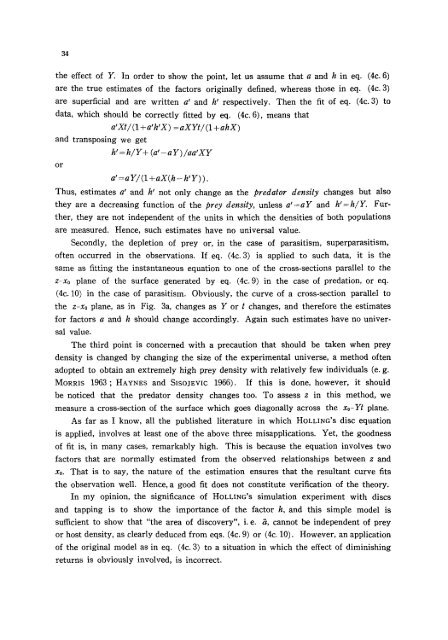A comparative study of models for predation and parasitism
A comparative study of models for predation and parasitism
A comparative study of models for predation and parasitism
You also want an ePaper? Increase the reach of your titles
YUMPU automatically turns print PDFs into web optimized ePapers that Google loves.
34<br />
the effect <strong>of</strong> Y. In order to show the point, let us assume that a <strong>and</strong> h in eq. (4c. 6)<br />
are the true estimates <strong>of</strong> the factors originally defined, whereas those in eq. (4c. 3)<br />
are superficial <strong>and</strong> are written a' <strong>and</strong> h' respectively. Then the fit <strong>of</strong> eq. (4c. 3) to<br />
data, which should be correctly fitted by eq. (4c. 6), means that<br />
a'Xt/ (1 + a'h'X) = aXYt/ (1 + ahX)<br />
<strong>and</strong> transposing we get<br />
h'=h/Y+ (a'-aY)/aa'XY<br />
or<br />
a'=aY/ (l +aX(h- h'Y) ).<br />
Thus, estimates a' <strong>and</strong> h' not only change as the predator density changes but also<br />
they are a decreasing function <strong>of</strong> the prey density, unless a'=aY <strong>and</strong> h'=h/Y. Fur-<br />
ther, they are not independent <strong>of</strong> the units in which the densities <strong>of</strong> both populations<br />
are measured. Hence, such estimates have no universal value.<br />
Secondly, the depletion <strong>of</strong> prey or, in the case <strong>of</strong> <strong>parasitism</strong>, super<strong>parasitism</strong>,<br />
<strong>of</strong>ten occurred in the observations. If eq. (4c. 3) is applied to such data, it is the<br />
same as fitting the instantaneous equation to one <strong>of</strong> the cross-sections parallel to the<br />
Z-Xo plane <strong>of</strong> the surface generated by eq. (4c. 9) in the case <strong>of</strong> <strong>predation</strong>, or eq.<br />
(4c. 10) in the case <strong>of</strong> <strong>parasitism</strong>. Obviously, the curve <strong>of</strong> a cross-section parallel to<br />
the Z-Xo plane, as in Fig. 3a, changes as Y or t changes, <strong>and</strong> there<strong>for</strong>e the estimates<br />
<strong>for</strong> factors a <strong>and</strong> h should change accordingly. Again such estimates have no univer-<br />
sal value.<br />
The third point is concerned with a precaution that should be taken when prey<br />
density is changed by changing the size <strong>of</strong> the experimental universe, a method <strong>of</strong>ten<br />
adopted to obtain an extremely high prey density with relatively few individuals (e. g.<br />
MORRIS 1963; HAYNES <strong>and</strong> SISOJEVIC 1966).<br />
If this is done, however, it should<br />
be noticed that the predator density changes too. To assess z in this method, we<br />
measure a cross-section <strong>of</strong> the surface which goes diagonally across the xo-Yt plane.<br />
As far as I know, all the published literature in which HOLLING'S disc equation<br />
is applied, involves at least one <strong>of</strong> the above three misapplications. Yet, the goodness<br />
<strong>of</strong> fit is, in many cases, remarkably high. This is because the equation involves two<br />
factors that are normally estimated from the observed relationships between z <strong>and</strong><br />
x0. That is to say, the nature <strong>of</strong> the estimation ensures that the resultant curve fits<br />
the observation well. Hence, a good fit does not constitute verification <strong>of</strong> the theory.<br />
In my opinion, the significance <strong>of</strong> HOLLING'S simulation experiment with discs<br />
<strong>and</strong> tapping is to show the importance <strong>of</strong> the factor h, <strong>and</strong> this simple model is<br />
sufficient to show that "the area <strong>of</strong> discovery", i.e. /i, cannot be independent <strong>of</strong> prey<br />
or host density, as clearly deduced from eqs. (4c. 9) or (4c. 10). However, an application<br />
<strong>of</strong> the original model as in eq. (4c. 3) to a situation in which the effect <strong>of</strong> diminishing<br />
returns is obviously involved, is incorrect.















